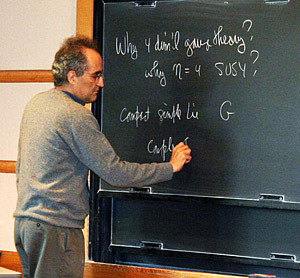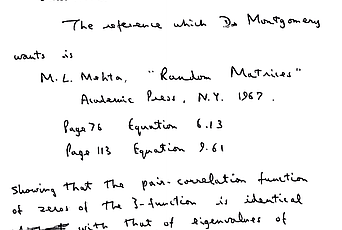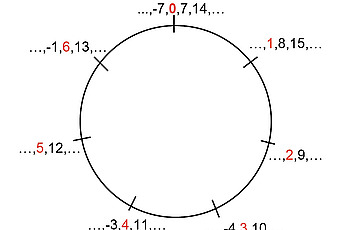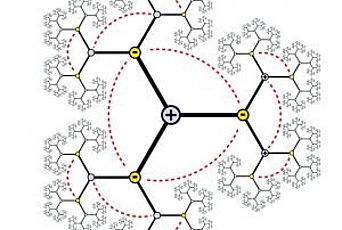Algebraic Geometry: The Interface with and Influence of Physics

On the occasion of the 1993 dedication of Simonyi Hall, Phillip Griffiths, then-Director of the Institute, spoke on “Mathematics—From Servant to Partner” in which he described how the relationship between mathematics and other disciplines had evolved substantially. “Mathematics functions not so much above or below other disciplines, but within and around them,” stated Griffiths. “It is growing into the status of a full and interactive partner.”
Today, one of the most active areas of interaction is in algebraic geometry, the topic of this year’s special program in the School of Mathematics. “The field of algebraic geometry is particularly noteworthy in the way in which it interacts with many of the other branches of mathematics, algebra, analysis, topology, number theory, and more recently computer science,” said Griffiths, now Professor in the School of Mathematics. “It also has a very long and distinguished tradition here at the Institute in that many of the Faculty members over the years have worked in various aspects in algebraic geometry.”
Algebraic geometry concerns the study of algebraic varieties, which are the common solution sets of polynomial equations. In the 1960s and 1970s its foundations were revolutionized by the French school of algebraic geometry, especially through the work of Alexander Grothendieck. “I think what one has seen during the period I have worked or observed the field has been the resolution of many but not all of the classical problems that came to us from the Italians and the great geometers of the past,” said Griffiths, who has contributed to the reconceptualization of the field with analytical and differential geometric methods and through his pioneering work on the variations of Hodge structures that are now very important in the study of mirror symmetry.
“The space of interest is the space of solutions but I very rarely look at these spaces as solutions to something,” said current School of Mathematics Member Mark Andrea de Cataldo, who with fellow Member Luca Migliorini studies the Hodge theory and the topology of algebraic varieties and algebraic maps between them. “If you slice a sphere in one direction you see circles, if you slice in another direction you see circles. No matter what direction you choose you see circles. If you slice a football you see circles in one direction but you see ellipses in another direction. So you see something is changing. The shape of the slices can tell you something about the original object. Very often I look at the slices and I try to say something about the big picture, the original object.”
School of Mathematics Professor Pierre Deligne used algebraic geometry to prove the analogue of the Riemann hypothesis for varieties over finite fields, one of the so-called Weil conjectures on arithmetic properties of algebraic varieties proposed by the late School of Mathematics Professor André Weil in 1949. These conjectures stimulated the development of modern algebraic geometry, and their proof is regarded as one of its most important achievements. Andrew Wiles, former Member in the School of Mathematics (1981–82, 1991–92, 1995–2004), also used the tools developed in algebraic geometry in his proof of Fermat’s last theorem.
In recent years the interaction between algebraic geometry and theoretical physics has been particularly fruitful. “The Institute has been perhaps the central place where this interaction has occurred,” said Griffiths. In his theory of general relativity, Albert Einstein derived general relativity almost as a branch of geometry, said Griffiths. “That point of view has been greatly extended by the modern theoretical physicists especially here at the Institute, people working in and near string theory,” said Griffiths. “Whereas with Einstein it was differential geometry that was the most relevant, for modern theoretical physics it is algebraic geometry. Algebraic geometry is the central aspect of geometry for the physicists now.”
This year’s program in algebraic geometry included two workshops on homological mirror symmetry, which Member Jaya Iyer, whose current research involves studying the Chern invariants of Flat bundles on quasi-projective variety and their extensions on good compactifications, found of interest. “My research doesn’t fit into it as yet but I hope I can use their definitions and conceptions to understand derived categories and maybe algebraic cycles and some relations there.”
At the homological mirror symmetry workshop in March, Edward Witten, Charles Simonyi Professor in the School of Natural Sciences and arguably the world’s leading string theorist, spoke about new interactions stemming from the link between gauge theory and the geometric Langlands program. “In recent years algebraic geometry and mathematical physics have begun to interact very deeply mostly because of string theory and mirror symmetry,” said Migliorini. “This crowd of problems suggested by mathematical physicists began to give statements that ought to be true and provable by algebraic geometric means. Mathematical physicists made some guesses based on physics and some really amazing predictions have stimulated a lot of research. This has made algebraic geometry a very hot topic.”


